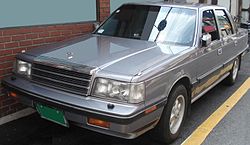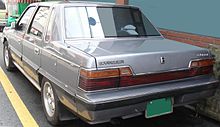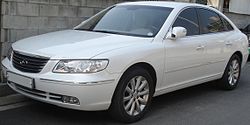Hyundai Grandeur
| Hyundai Grandeur | |
|---|---|
| Production period: | since 1986 |
| Class : | upper middle class |
| Body versions : | limousine |
| Previous model: | Hyundai Granada |
The Hyundai Grandeur ( Hangeul : 현대 그랜저) is an upper mid -range car model with front-wheel drive .
First generation
| First generation | |
|---|---|
| Production period: | 1986-1992 |
| Body versions : | limousine |
| Engines: |
Petrol engines : 2.0-3.0 liters (125-145 kW) |
| Length: | 4865 mm |
| Width: | 1725 mm |
| Height: | 1450 mm |
| Wheelbase : | 2690 mm |
| Empty weight : | 1330 kg |
The first generation of the Hyundai Grandeur was based on the Mitsubishi Debonair offered at the time . Initially the car was available with a 2.0 liter or optionally with a 2.4 liter four-cylinder engine, later the engine range was supplemented by a V6 engine with a 3.0 liter displacement.
Second generation
| Second generation | |
|---|---|
| Production period: | 1992-1998 |
| Body versions : | limousine |
| Engines: |
Petrol engines : 3.0-3.5 liters (88-139 kW) |
| Length: | 4980 mm |
| Width: | 1810 mm |
| Height: | 1445 mm |
| Wheelbase : | |
| Empty weight : | |
The second generation was also based on the Mitsubishi Debonair, which was renewed at the same time. Only V6 engines with a displacement of up to 3.5 liters were available.
Third generation
| Third generation | |
|---|---|
|
Hyundai XG 30 (1998-2003) |
|
| Production period: | 1998-2005 |
| Body versions : | limousine |
| Engines: |
Petrol engines : 2.5-3.5 liters (121-145 kW) |
| Length: | 4865 mm |
| Width: | 1825 mm |
| Height: | 1420 mm |
| Wheelbase : | |
| Empty weight : | 1679 kg |
The third generation went on sale in December 1998, but did not hit the US market until 2001. In Europe and North America, this generation was sold as the Hyundai XG . You could first acquire the XG 30 (in North America as the XG 300) with a 3.0-liter engine, later the revised XG 350 with a 3.5-liter engine. Both models had the same platform and engine range as the Kia Opirus .
Initially, a 3.0-liter V6 with 138 kW (188 hp) was offered, in some countries the 2.5-liter V6 from the Sonata could also be ordered.
At the beginning of 2003, a facelift followed and a renaming to XG 350 (now with a 3.5-liter V6 with 145 kW / 197 PS). The drive was provided by an electronically controlled five-speed automatic transmission , which, among other things, adapted to the driver's driving style and also had a manual shift mode (H-Matic).
Technical specifications
3.0L Sigma V6 :
- Number of cylinders / valves: 6/24
- Engine type: V type, DOHC
- Bore: 91.1 mm
- Stroke: 76.0 mm
- Displacement: 2972 cm³
- Compression ratio: 10.0
- Firing order: 1–2–3–4–5–6
- Drive mechanism: toothed belt
- Power: 138 kW (188 hp) at 6000 min -1
- Maximum torque: 255 Nm at 4000 min -1
- Top speed: 225 km / h
- Acceleration from 0-100 km / h: 8.9 s
- Fuel consumption (combined): 10.7 l / 100 km
- Tank capacity: 70 l
Transmission:
- Designation: F5A51-2
- Torque converter type: 3 elements, 1 stage, 2 phases
- Transmission type: 5 forward gears, 1 reverse gear
Gear ratio 1st gear: 3.789
2nd gear: 2.057
3rd gear: 1.421
4th gear: 1,000
5th gear: 0.731
Reverse gear: 3.865 Final
gear ratio: 3.333- Lubricant capacity: 8.5 liters
design
With an external length of almost 4.90 meters and a width of over 1.80 meters, the Hyundai XG was in the upper mid-range format. Many chrome elements were used on the body. There was no reference to the brand identity on the front, and the Hyundai logo was on the rear. It was worth mentioning that the frameless side windows gave the vehicle the appearance of a coupé. The Hyundai XG also had an antenna integrated into the rear window.
The XG was only offered as a four-door notchback sedan .
Furnishing
The Hyundai XG had extensive standard equipment, including a. with leather seats with electrical adjustment and memory function, heated seats, electric window lifters front and rear, central locking with remote control, alarm system, automatic air conditioning with air quality sensor , cruise control, light metal rims, automatically dimming interior mirror, automatic light, etc. For safety, front and side airbags, ABS , traction control , electronic Brake booster at.
Only a metallic finish and a sliding glass roof cost an extra charge. The Decada special models were also equipped with an auxiliary heater . They were offered with black leather and a wooden steering wheel, but only in a green metallic exterior paintwork.
distribution
In Germany, the Hyundai XG 30 only had the meaning of a niche model. Despite the comparatively low price at the time and very extensive equipment, the model found only a few buyers. According to the Federal Motor Transport Authority, only 1025 XG 30 (138 kW) and 425 XG 350 (145 kW) were permitted in Germany on January 1, 2009 . In other countries - particularly the USA and South Korea - the Hyundai model was far more successful.
Fourth generation
| Fourth generation (TG) | |
|---|---|
|
Hyundai Grandeur (2005-2010) |
|
| Production period: | 2005-2011 |
| Body versions : | limousine |
| Engines: |
Otto engines : 2.4–3.8 liters (121–196 kW) Diesel engine : 2.2 liters (114 kW) |
| Length: | 4895 mm |
| Width: | 1832 mm |
| Height: | 1475 mm |
| Wheelbase : | 2780 mm |
| Empty weight : | 1739-1788 kg |
Since Hyundai wants to present itself as a sporty brand, the fourth generation of the Grandeur, like other current Hyundai models, has coupé-like lines. With a length of just under 4.90 meters, there is ample space in the interior both at the front and at the rear.
Furnishing
The Grandeur has standard equipment that is unusual even in this class. Practically all extras are already included in the basic equipment. The standard equipment includes: leather seats, heated seats, eight airbags, alarm system, central locking with remote control, automatic air conditioning, xenon headlights, aluminum rims, ESP, automatically dimming interior mirror, parking aid, cruise control and, last but not least, a navigation system.
Only a panoramic glass sunroof and metallic paint are offered at an additional cost.
A total of four exterior colors (two silver tones, black and dark red) and two interior colors are available. The color combination of the exterior and interior colors is specified at the factory.
In addition to ABS and ESP, eight airbags and active headrests for the driver and front passenger contribute to safety. The safety of the steel frame should be guaranteed by 300 crash tests carried out with prototypes in the development phase.
distribution
The Grandeur was mainly offered in Japan , the USA (there under the name "Azera") and on the home market of Korea, where it was produced in the Asan plant. These countries are considered to be the three largest sales markets for this model. In Germany , Hyundai reckoned with sales of 2000 vehicles per year.
In the 2006 FIFA World Cup players and was VIPs of Grandeur provided.
Engines
In addition to the 3.3-liter V6 petrol engine with 173 kW (235 hp) and five-speed automatic transmission, there was also a 2.2-liter R4 diesel engine for Europe since spring 2007 . In the USA, the Grandeur was available in addition to the 3.3-liter with a 3.8-liter V6 gasoline engine with 196 kW (266 hp). In South Korea, in addition to the two V6s, a 2.7-liter V6 with liquefied gas and a 2.4-liter four-cylinder petrol engine with 164 hp were also available.
Technical specifications
3.3 V6 :
- Number of cylinders / valves: 6/24
- Displacement: 3342 cm³
- Power: 173 kW (235 hp) at 6000 min -1
- Maximum torque: 303.8 Nm at 3500 min -1
- Top speed: 237 km / h
- Acceleration from 0-100 km / h: 7.8 s
- Fuel consumption (inner-city, extra-urban, combined): 15.1 / 7.4 / 10.2 l / 100 km
- CO 2 emissions: 245 g / km
2.2 CRDI :
- Number of cylinders / valves: 4/16
- Displacement: 2188 cm³
- Power: 114 kW (155 PS)
- Maximum torque: 343 Nm at 1800 to 2500 min -1
- Top speed: 202 km / h
- Acceleration from 0-100 km / h: 11.4 s
- Fuel consumption (combined): 7.9 l / 100 km
- CO 2 emissions: 208 g / km
Facelift
A slightly revised version was presented in Korea in mid-December 2009. The most noticeable changes are the wider radiator grille and redesigned headlights with an LED band as daytime running lights. The taillights also received LED technology. The twin exhaust of the V6 engines is now sportier and fully integrated into the rear bumper. In addition, the Lambda series was switched to the Lambda II series and these were connected to six-stage instead of five-stage machines. Apart from an automatic turn signal, with which the vehicle flashes three times even after tapping the turn signal lever, there were no further changes.
The revised version will be exported to the USA, for example, based on previous demand, but no longer to Germany or Canada, among others. The websites listed in Europe also show the original version at the end of 2010, so that production will obviously continue in parallel.
Fifth generation (HG, 2011-2017)
| Fifth Generation (HG) | |
|---|---|
|
Hyundai Grandeur (2011-2017) |
|
| Production period: | 2011-2017 |
| Body versions : | limousine |
| Engines: |
Petrol engines : 2.0-3.3 liters (132-218 kW) |
| Length: | 4910 mm |
| Width: | 1860 mm |
| Height: | 1480 mm |
| Wheelbase : | 2845 mm |
| Empty weight : | 1516-1675 kg |
The fifth generation of the Hyundai Grandeur appeared on January 13, 2011. The design is based on the Hyundai Sonata YF , with a continuous strip of lights at the rear like the previous model.
All engines have direct injection , the previous V6 engines have been replaced by the Lambda II GDI series , the four-cylinder Theta II GDI is used as the basic engine . The Grandeur HG offers an adaptive cruise control which , if necessary, brakes to a standstill if the vehicle in front brakes abruptly. The Grandeur is no longer offered in Europe. In North America it is sold as the Hyundai Azera .
| model | 2.4 | 3.0 | 3.3 V6 |
|---|---|---|---|
| cylinder | 4th | 6th | 6th |
| Displacement (cm³) | 2359 | 2999 | 3342 |
| Max. Power (kW / PS) | 132/180 at 6000 | 184/250 at 6400 | 218/296 at 6400 |
| Max. Torque (Nm) | 231 at 4000 | 282 at 5000 | 346 at 5200 |
| Top speed (km / h) | 210 | 223 | 250 |
| Gearbox (standard) | 6-speed manual transmission | 6-speed manual transmission | 6- speed automatic transmission |
| Acceleration (0-100 km / h) | 9.8 s | 8.4 s | unknown |
| Combined consumption (l / 100 km) | 8.9 N | 9.8 N | 10.2 N |
Sixth generation (IG, 2016–)
| Sixth generation (IG) | |
|---|---|
|
Hyundai Grandeur (since 2016) |
|
| Production period: | since 2016 |
| Body versions : | limousine |
| Engines: |
Gasoline engines : 2.4-3.5 liters (140-213 kW) |
| Length: | 4930 mm |
| Width: | 1865 mm |
| Height: | 1470 mm |
| Wheelbase : | 2845 mm |
| Empty weight : | 1616-1704 kg |
The sixth generation was introduced on October 27, 2016. Due to low sales and the introduction of the new luxury brand Genesis , the Azera will not receive a successor in North America.
Technical specifications
| Parameters | 2.4 GDi | 3.0 MPi | 3.0 GDi | 3.5 MPi |
|---|---|---|---|---|
| Construction period | since 2016 | |||
| Engine characteristics | ||||
| Engine type | R4 petrol engine | V6 petrol engine | ||
| Displacement | 2359 cc | 2999 cc | 3470 cc | |
| Max. power | 140 kW (190 PS) at 6000 rpm |
184 kW (250 PS) at 6400 rpm |
191 kW (261 hp) at 6400 rpm |
213 kW (290 hp) at 6600 rpm |
| Max. Torque | 241 Nm at 4000 rpm |
284 Nm at 5000 rpm |
304 Nm at 5300 rpm |
338 Nm at 5000 rpm |
| Power transmission | ||||
| Drive, as standard | Front wheel drive | |||
| Gearbox, as standard | 6- speed automatic transmission | 8-speed automatic transmission | ||
| Readings | ||||
| Top speed | 213 km / h | 222 km / h | 230 km / h | |
|
Acceleration, 0-100 km / h |
9.7 s | 8.4 s | 7.9 s | 7.4 s |
|
Fuel consumption over 100 km (combined) |
8.3 l super | 9.5 l super | 9.1 l super | 10.7 l super |
| CO 2 emissions (combined) | 191 g / km | 227 g / km | 212 g / km | 223 g / km |
Individual evidence
- ↑ The number of passenger cars on January 1, 2009 by manufacturer, trade name, selected features and cubic capacity. (PDF) In: Statistische Mitteilungen des Kraftfahrt-Bundesamt FZ 2, January 1, 2009. Kraftfahrt-Bundesamt, July 2009, p. 123 , accessed on December 23, 2015 .
- ↑ All Azera's sold in North America and other markets are produced at Asan.
- ↑ http://www.autoblog.com/2009/12/17/visions-of-grandeur-refreshed-hyundai-azera-on-the-horizon/
- ↑ Changes to the Hyundai Grandeur Facelift
- ^ Hyundai Grandeur in Spain
- ^ Hyundai Grandeur in Austria
- ↑ Hyundai Grandeur Facelift in North America
- ↑ Presentation of the fifth generation Hyundai Grandeur (HG)
- ↑ Technical details of the Hyundai Grandeur HG ( Memento of the original dated December 6, 2010 in the Internet Archive ) Info: The archive link was inserted automatically and has not yet been checked. Please check the original and archive link according to the instructions and then remove this notice.
- ^ Hyundai Will Drop The Azera From Its US Lineup















